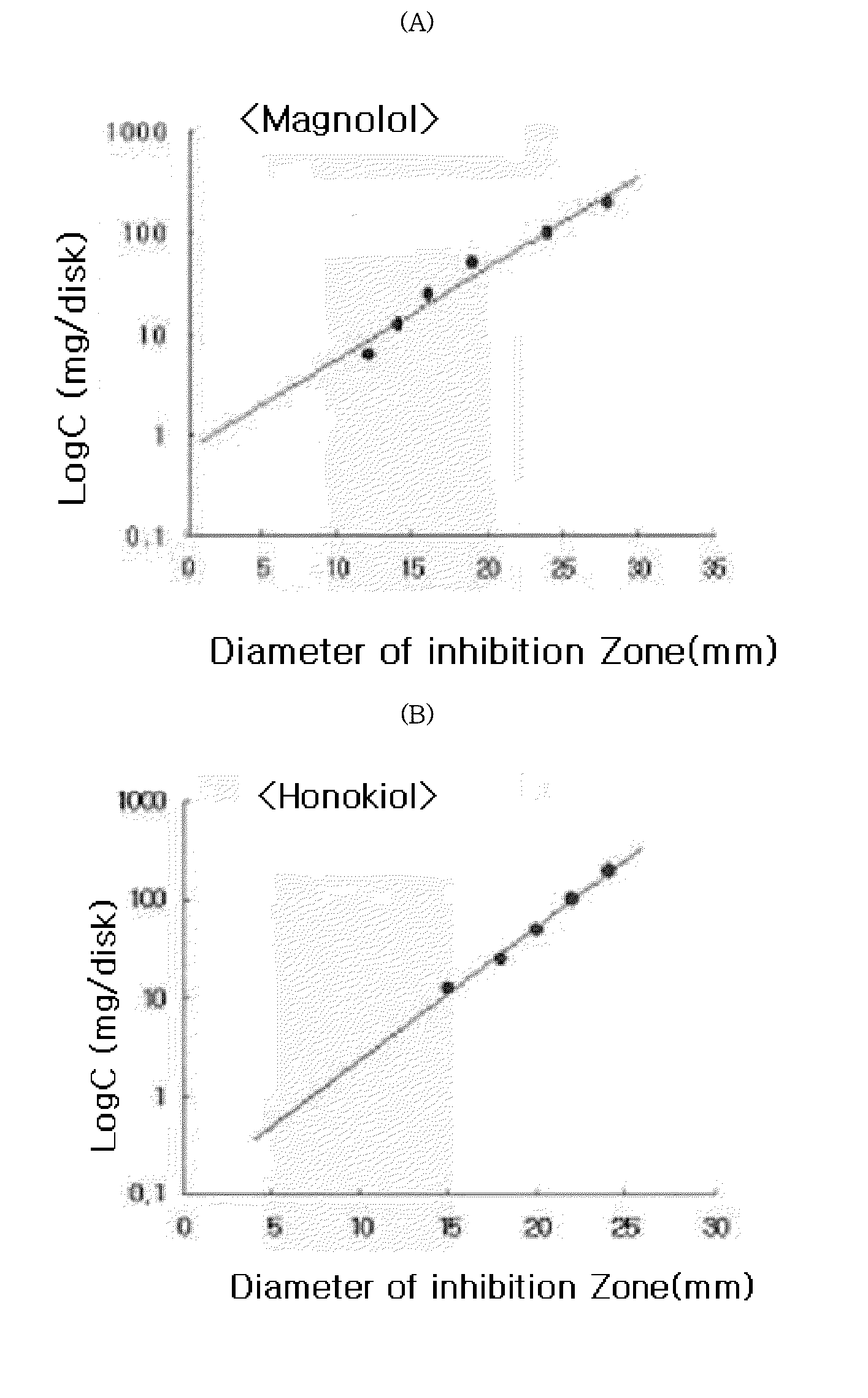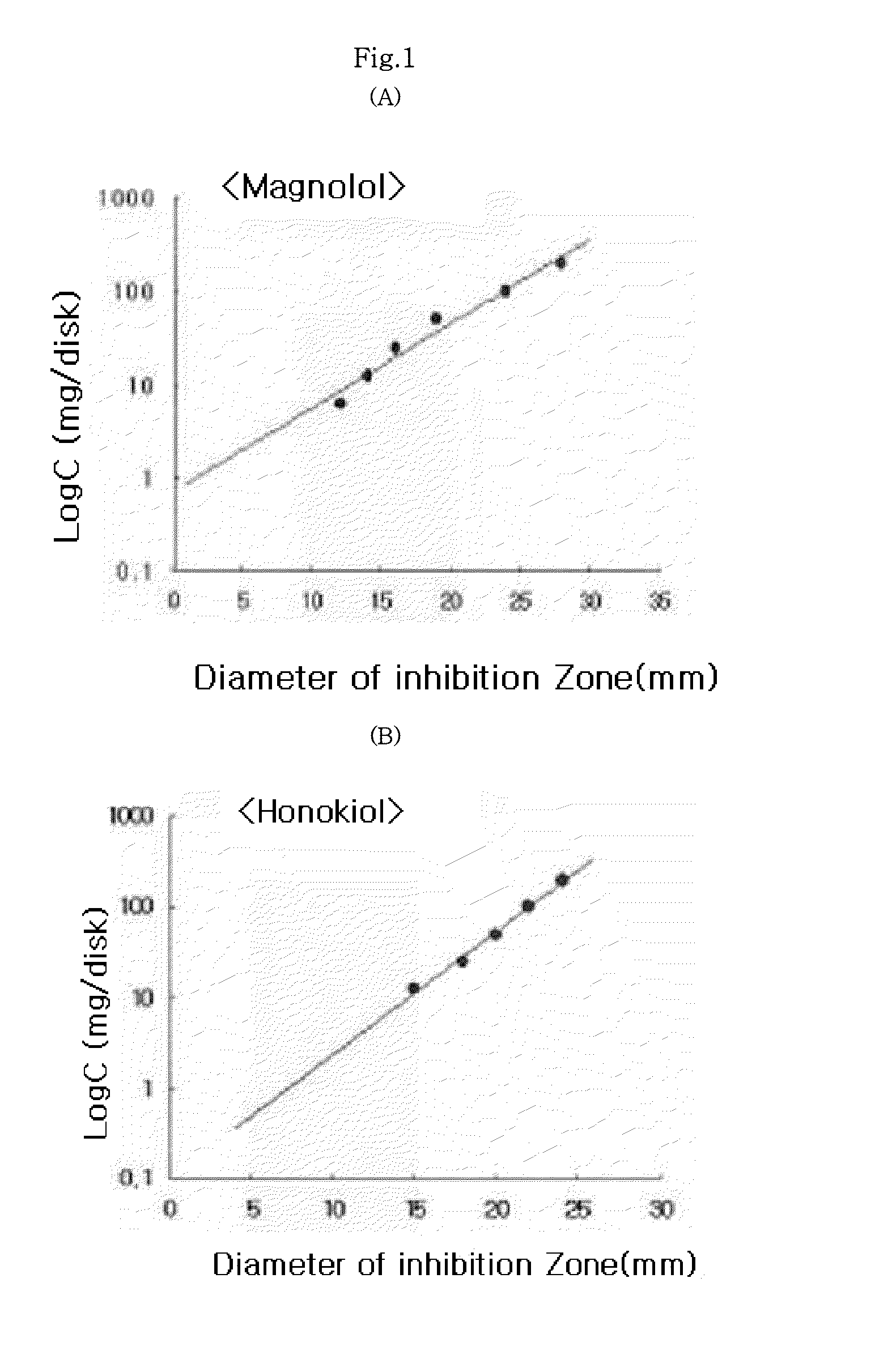Method of improving atopic dermatological diseases, in which a composition comprising magnolol, honokiol or a combination thereof is administered to a patient with atopic dermatological diseases
a technology of atopic dermatological diseases and compositions, applied in the direction of biocide, synthetic polymeric active ingredients, drug compositions, etc., can solve the problems of skin atrophy, vasodilation, depigmentation, striae distensae, etc., and achieve the effect of reducing the risk of skin atrophy, and improving the quality of li
- Summary
- Abstract
- Description
- Claims
- Application Information
AI Technical Summary
Benefits of technology
Problems solved by technology
Method used
Image
Examples
example 1
Antibacterial Activity of Magnolol and Honokiol Against Staphylococcus aureus
[0029]The standardized filter-paper disk agar diffusion method was used to determine the antibacterial activity of magnolol and honokiol against Staphylococcus aureus. This method was also well-known as Kirby-Bauer method, and has been widely used to determine the antibacterial activity (see, European Journal of Pharmacology, Junho Park et al, 2004, 496(1-3), 189-195). Briefly, Staphylococcus aureus cells were incubated with brain heart infusion (BHI) broth at 37° C. under anaerobic conditions until they reach the stationary phase. Approximately 1×106 bacteria cells were mixed with 7 ml of BHI agar medium containing 0.8% phytoagar and then, poured on the agar plate containing 1.5% phytoagar. The filter-paper discs (10 mm diameter) were treated with magnolol and honokiol at respective test concentrations, and then placed on the BHI agar plate inoculated with the test bacteria. The plate was incubated at 37°...
example 2
Minimum Inhibitory Concentration (MIC) of Magnolol and Honokiol
[0030]The test was conducted to determine the Minimum Inhibitory Concentrations (MIC) of magnolol and honokiol. Staphylococcus aureus incubated for 24 hours was introduced into 3 ml of brain heart infusion broth, and at the same time, magnolol and honokiol were respectively added thereto, and then incubated for 24 hours at 37° C. under anaerobic conditions. To determine MICs of honokiol and magnolol the two-fold serial dilution method was used. As used herein, MIC is defined as the minimum concentration at which the growth of microorganism is inhibited. As presented in Table 2, it could be confirmed that MICs of magnolol and honokiol for Staphylococcus aureus were 6 μg / ml and 2 μg / ml, respectively. That is, it can be seen that the antibacterial activity of honokiol is higher than that of magnolol.
TABLE 2MIC of agents (μg / ml)MicroorganismHonokiolMagnololS. aureus26
example 3
Determination of the Minimum Bacteriocidal Concentration (MBC) of Magnolol and Honokiol for Staphylococcus aureus
[0031]The inhibition of bacterial growth with a certain substance is the result obtained by inhibiting the proliferation of respective cells or killing the cells. The growth of bacteria can be again initiated by removing such substance in case where the substance exhibits the inhibition of proliferation (bacteriostatic activity), but could not be restarted in case of the killing of bacteria. The following experiment was conducted to determine the Minimum Bacteriocidal Concentration (MBC). First, the same procedures as the determination of MIC were conducted in the liquid culture medium, and then a portion of the culture medium in the test tube in which no proliferation was shown was taken, diluted to remove magnolol and honokiol therefrom, and then incubated on the solid culture medium and observed for the colony formation after 24 hours. At this time, MBC means the mini...
PUM
| Property | Measurement | Unit |
|---|---|---|
| concentration | aaaaa | aaaaa |
| concentration | aaaaa | aaaaa |
| concentration | aaaaa | aaaaa |
Abstract
Description
Claims
Application Information
 Login to View More
Login to View More - R&D
- Intellectual Property
- Life Sciences
- Materials
- Tech Scout
- Unparalleled Data Quality
- Higher Quality Content
- 60% Fewer Hallucinations
Browse by: Latest US Patents, China's latest patents, Technical Efficacy Thesaurus, Application Domain, Technology Topic, Popular Technical Reports.
© 2025 PatSnap. All rights reserved.Legal|Privacy policy|Modern Slavery Act Transparency Statement|Sitemap|About US| Contact US: help@patsnap.com



